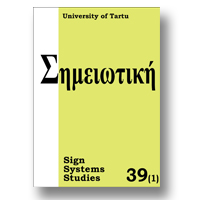|
|
|
21.
|
Sign Systems Studies:
Volume >
42 >
Issue: 2/3
Gisela Bruche-Schulz
В какой момент при чтении текста начинается семиозис? О перцепции события
view |
rights & permissions
| cited by
|
|
|
|
|
|
|
22.
|
Sign Systems Studies:
Volume >
42 >
Issue: 2/3
Gisela Bruche-Schulz
Kus on teksti lugemisel semioosi algus? Sündmuse tajumisest
view |
rights & permissions
| cited by
|
|
|
|
|
|
|
23.
|
Sign Systems Studies:
Volume >
42 >
Issue: 2/3
Luis Emilio Bruni, Sarune Baceviciute
On the embedded cognition of non-verbal narratives
abstract |
view |
rights & permissions
| cited by
Acknowledging that narratives are an important resource in human communication and cognition, the focus of this article is on the cognitive aspects ofinvolvement with visual and auditory non-verbal narratives, particularly in relation to the newest immersive media and digital interactive representational technologies. We consider three relevant trends in narrative studies that have emerged in the 60 years of cognitive and digital revolution. The issue at hand could have implications for developmental psychology, pedagogics, cognitive science, cognitive psychology, ethology and evolutionary studies of language. In particular, it is of great importance for narratology in relation to interactive media and new representational technologies. Therefore we outline a research agenda for a bio-cognitive semiotic interdisciplinary investigation into how people understand, react to, and interact with narratives that are communicated through non-verbal modalities.
|
|
|
|
|
|
|
24.
|
Sign Systems Studies:
Volume >
42 >
Issue: 2/3
Luis Emilio Bruni, Sarune Baceviciute
О когниции невербальных нарративов
view |
rights & permissions
| cited by
|
|
|
|
|
|
|
25.
|
Sign Systems Studies:
Volume >
42 >
Issue: 2/3
Luis Emilio Bruni, Sarune Baceviciute
Mitteverbaalsete narratiivide kognitsioonist
view |
rights & permissions
| cited by
|
|
|
|
|
|
|
26.
|
Sign Systems Studies:
Volume >
42 >
Issue: 2/3
Riin Magnus
The role of trust in binding the perspectives of guide dogs and their visually impaired handlers
abstract |
view |
rights & permissions
| cited by
Building on anthropological discussions of perspectivism and (zoo)semiotic accounts of sign use by humans and other animals, the article explores the cooperation of a guide dog and its visually impaired handler as contingent on the mutual adjustment of two individual perspectives. A perspective is defined as a point of view which comprises the meanings as well as the forms of objects that the subject perceives and acts upon. On certain occasions, individual perspectives can be alligated to one another, resulting in a transformation of the meaningful worlds of the subjects. Three types of connections between individual perspectives are delineated in the paper, resulting in the formation of mimetic, collaborative and comparative double perspectives. Although all of them bear relevance for the guide dog team’s interactions, the collaborative double perspective is put under further scrutiny. The maintenance of the collaborative double perspective depends on the formation of trust between the two individuals. While investigating the conditions for the establishment of trust, a question is raised as to whether a shared communication system can serve as an ultimate ground for it.
|
|
|
|
|
|
|
27.
|
Sign Systems Studies:
Volume >
42 >
Issue: 2/3
Riin Magnus
Usalduse roll juhtkoerte ning nende nägemispuudega peremeeste perspektiivide sidumisel
view |
rights & permissions
| cited by
|
|
|
|
|
|
|
28.
|
Sign Systems Studies:
Volume >
42 >
Issue: 2/3
Riin Magnus
Роль доверия в связывании перспектив собак-поводырей и их незрячих хозяев
view |
rights & permissions
| cited by
|
|
|
|
|
|
|
29.
|
Sign Systems Studies:
Volume >
42 >
Issue: 2/3
Wendy Wheeler
The carrying: Material frames and immaterial meanings
view |
rights & permissions
| cited by
|
|
|
|
|
|
|
30.
|
Sign Systems Studies:
Volume >
42 >
Issue: 2/3
Frederik Stjernfelt
Diagrams, narratives and ‘reality’
view |
rights & permissions
| cited by
|
|
|
|
|
|
|
31.
|
Sign Systems Studies:
Volume >
42 >
Issue: 2/3
Ahti-Veikko Pietarinen
Applying Peirce in Tallinn and Helsinki
view |
rights & permissions
| cited by
|
|
|
|

